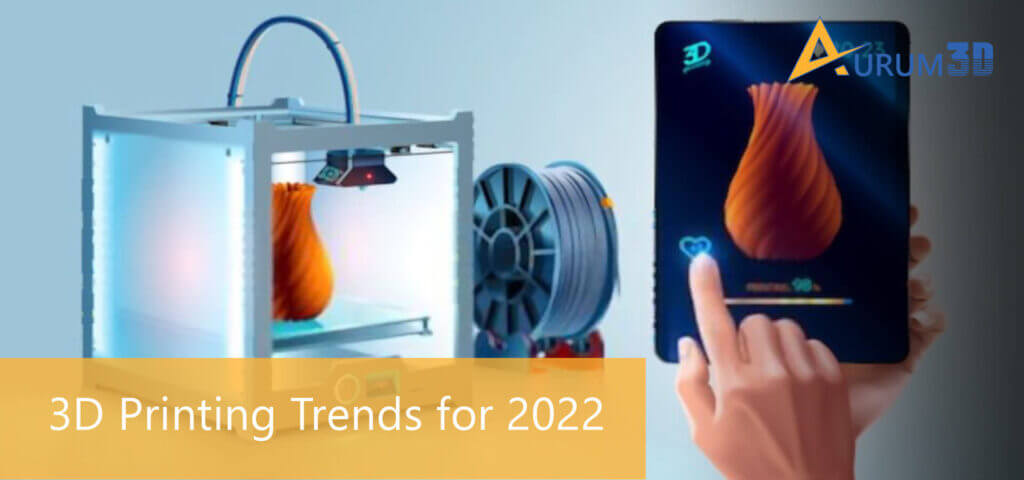The growth of the worldwide 3D printing market slowed down in 2021 due to the COVID-19 pandemic. But several industry studies suggest that the shipment of 3D printers and value of 3D-printed parts will grow steadily over the next decade.
According to TCT Magazine,
“The global shipment of 3D printers will continue to accelerate by overcoming the negative impact of pandemic-related disruptions.”
Likewise, a market research report published by Lux Report forecasts that the value of 3D-printed parts will increase at a 15% compound annual growth rate (CAGR) over the next few years and cross $51 billion in 2030. The growth of 3D printing technologies and services will be driven by companies, startups, and hobbyists across regions and sectors.
They will foster innovation and invest in R&D to create new 3D printing use cases regularly. The new applications and innovations will change 3D printing trends in 2022 frequently. Some of the hottest 3D printing trends in 2021 will become obsolete in 2022. At the same time, both individuals and enterprises have to look out for some of the hottest 3D printing trends in 2022 to stay relevant and beat the competition.
7 Emerging 3D Printing Trends to Look Out for in 2022
1) Production instead of Prototyping
Rapid prototyping is one of the common and important use cases of 3D printing technologies. Enterprises from various sectors use 3D printers to evaluate ideas and concepts with reduced prototyping time and cost. In 2022, rapid prototyping will remain one of the major use cases of 3D printing technologies.
But the number of enterprises using 3D printing for the production of functional parts and end-use parts will increase by 80%. In 2022, many manufacturing companies will replace conventional production methods will 3D printing to leverage benefits in the form of time, cost, and flexibility. Hence, 3D printing technologies will be used widely for the production of components and parts on demand.
2) 3D Printing Automation
Leading companies have already started 3D printing automation by leveraging next-generation artificial intelligence (AI) and machine learning (ML) technologies. Many 3D printing manufacturers have launched next-generation 3D printers that feature automated and digital solutions.
The automated and digital solutions are proprietary software solutions that facilitate the automation of small batch production and mass production customization. Many enterprises will adopt automated 3D printing in 2022 to overcome constraints related to skills and resources.
3) Industry-Specific 3D Printers
There was a time when the same 3D printers were being used to produce a variety of three-dimensional items. But enterprises these days look for 3D printers that are customized according to their precise needs. For instance, construction companies need large and specialized 3D printers that build prefabricated houses by depositing specific materials like concrete layer by layer.
Industries like aerospace and healthcare are investing in R&D to create 3D printers that cater to their precise needs. For instance, NASA has showcased the OSAM-2 project that aims to launch a 3D printer with robotic arms that can build and assemble small spacecraft in space.
Likewise, healthcare companies have developed 3D printers with the capability to print new bones using ceramic-based ink as the primary filament. In 2022, most enterprises will invest in industry-specific 3D printers. Also, businesses will continue to avail of professional 3D printing services to access industry-specific 3D printers.
4) 3D Printing Process Customization
Engineers always combine the appropriate 3D printer and 3D printing materials according to precise project needs. But no 3D printer can produce a variety of three-dimensional models accurately and precisely through a standardized printing process.
Engineers have to customize and finetune the 3D printing process according to the item to be manufactured. The qualified and certified professionals always evaluate project needs elaborately to decide the right way to 3D print the product. The 3D printing process customization will become an ongoing process in 2022.
5) Metal 3D Printing
According to a market size and share report published by Grand View Research, “The global metal 3D printing market size was valued at USD 3.15 billion in 2020 and is expected to expand at a compound annual growth rate (CAGR) of 22.9% from 2021 to 2028.” In 2022, enterprises from various sectors will leverage metal 3D printing to produce complex finished parts and tool components.
However, metal is not a form of fully accessible 3D printing material like thermoplastics. The 3D printing manufactures and users have to overcome a slew of obstacles to make metal accessible. Also, they have to explore ways to curtail overall project costs by controlling the high-strength materials.
6) Accessible 3D Printing Materials
Every enterprise these days have the option to choose from many types of 3D printers and 3D printing materials. But a large percentage of 3D-printed products are created using plastic/polymer filaments. However, several studies suggest a steady increase in the usage of 3D printing materials like ceramics, glass, and metal.
At the same time, many engineers these days use composite 3D printing materials like carbon fiber to leverage benefits like durability and cost. In 2022, enterprises will continue to use various types of 3D printing materials according to precise project needs. Also, they will have the option to choose from many new accessible 3D printing materials.
7) Growing In-House Expertise
Unlike large businesses, small businesses and startups lack the resources and skills to use in-house 3D printers. They avail of professional 3D printing services to access the appropriate 3D printer and 3D printing materials without escalating project costs. In 2022, the demand for professional 3D printing services will grow consistently.
But many companies will incur capital expenditure to leverage the benefits of 3D printing technologies fully. The capital expenditure will make enterprises focus on fostering in-house expertise. Hence, the demand for qualified and certified 3D printing professionals will increase rapidly in 2022.
3D printing technologies have been evolving consistently. Likewise, new 3D printing use cases are being created regularly. Hence, 3D printing trends in 2022 will keep changing from time to time. Both individuals and enterprises have to adopt emerging 3D printing trends proactively in 2022 to leverage the latest additive manufacturing technologies.


Interesting blog, good information is provided regarding 3D printing services. Was very useful, thanks for sharing this useful blog with us.